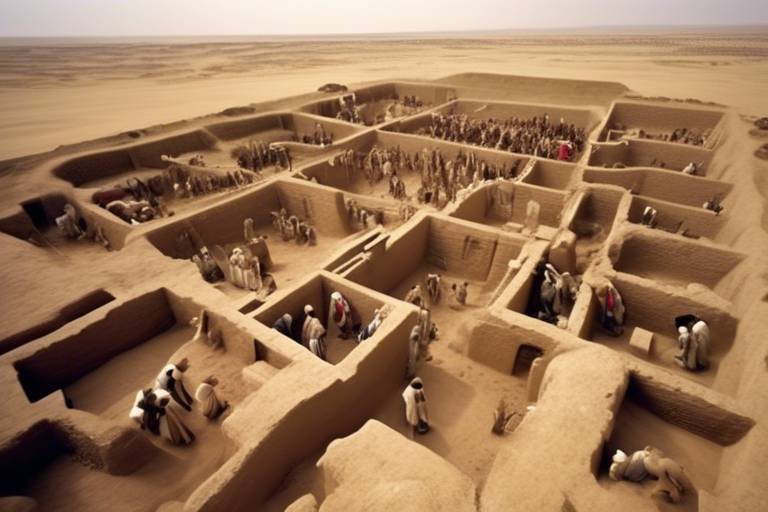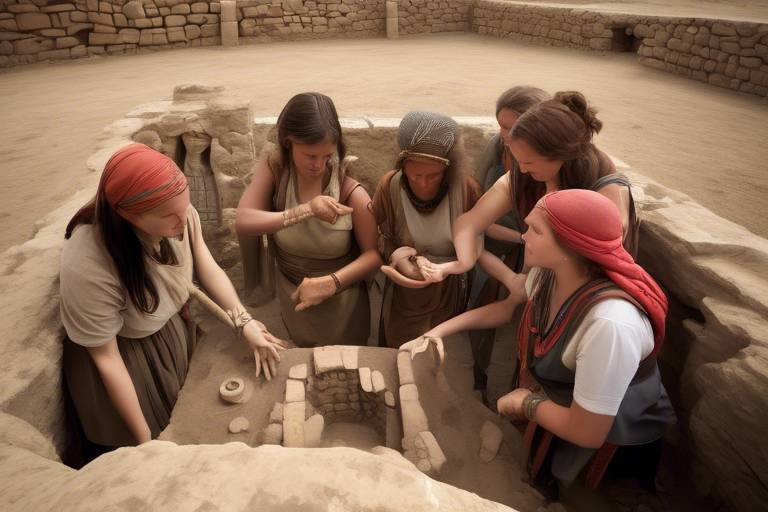How Artifacts Tell Stories of Ancient Societies
Artifacts are not mere objects of the past; they are storytellers of ancient societies, whispering tales of bygone eras and lost civilizations. Each artifact holds within its aged walls a narrative waiting to be unraveled, a glimpse into the lives and cultures of those who came before us. Through the intricate details and unique characteristics they possess, artifacts serve as windows to the past, allowing us to piece together the puzzle of history.

Types of Artifacts
When delving into the world of ancient civilizations, artifacts play a crucial role in unraveling the mysteries of the past. These remnants of bygone eras come in various forms, each offering a unique glimpse into the lives and cultures of ancient societies.
One prevalent type of artifact is tools, which provide insights into the technological advancements and daily activities of ancient people. From primitive stone tools to intricate metal implements, these artifacts shed light on the skills and craftsmanship of our ancestors.
Pottery is another significant category of artifacts, showcasing the artistic talents and utilitarian needs of ancient societies. The intricate designs and diverse shapes of pottery vessels reveal cultural preferences, trade connections, and even culinary practices of the past.
Jewelry holds a special place among artifacts, symbolizing status, beliefs, and personal adornment in ancient civilizations. Whether crafted from precious metals or simple materials, these ornaments offer clues about social hierarchies, religious practices, and aesthetic preferences.
Artwork, including sculptures, paintings, and engravings, serves as a visual record of ancient cultures, capturing scenes from daily life, mythological tales, and religious ceremonies. These artistic expressions not only showcase the creativity of ancient artisans but also provide valuable cultural insights.

Artifact Preservation
Artifact preservation is a critical aspect of maintaining the integrity and historical value of ancient relics. These artifacts provide invaluable insights into the past, offering a glimpse into the lives, beliefs, and practices of ancient civilizations. Through meticulous preservation efforts, we can ensure that these artifacts remain intact for future generations to study and appreciate.
Conservation techniques play a crucial role in preventing the deterioration of artifacts over time. Methods such as proper storage in controlled environments, careful handling to avoid damage, and regular monitoring for signs of decay are essential in preserving these fragile pieces of history. Additionally, the use of advanced technologies, such as 3D scanning and digital documentation, has revolutionized the field of artifact preservation, allowing for detailed analysis and virtual conservation of artifacts.
Challenges in artifact preservation often stem from environmental factors, such as exposure to light, humidity, and temperature fluctuations, which can accelerate degradation. Cultural heritage sites face threats from pollution, urban development, and looting, further emphasizing the importance of implementing robust preservation strategies. Collaboration between archaeologists, conservators, and local communities is essential in safeguarding these artifacts and ensuring their long-term survival.

Symbolism in Artifacts
Symbolism in artifacts plays a crucial role in understanding the deep-rooted meanings and cultural significance embedded in ancient societies. These artifacts are not merely objects but symbolic representations of beliefs, values, and societal structures that offer a glimpse into the mindset of the people who created them. From intricate patterns on pottery to the motifs in jewelry, each artifact carries a story waiting to be deciphered.
One fascinating aspect of symbolism in artifacts is how they reflect the spiritual and religious beliefs of ancient civilizations. For example, the presence of certain symbols on ceremonial objects can provide insights into the rituals and practices that were central to their belief systems. These symbols often transcend language barriers, serving as a universal language that communicates ideas and concepts across generations.
Moreover, artifacts also hold symbolic meanings related to social hierarchies and power dynamics within ancient societies. The materials used, the craftsmanship employed, and the motifs chosen can all indicate the status of individuals or groups in the social structure. By decoding these symbols, historians and archaeologists can unravel the complexities of ancient societal norms and power structures.
Additionally, symbolism in artifacts can shed light on the interconnectedness of different cultures through trade and exchange. Objects found in archaeological sites far from their places of origin suggest a network of trade routes and cultural interactions that spanned vast distances. The symbols and motifs shared between distant civilizations reveal a shared visual language that transcended geographical boundaries.
By studying the symbolism in artifacts, researchers can piece together the puzzle of ancient societies, uncovering hidden meanings and narratives that offer a glimpse into the rich tapestry of human history. Each symbol, motif, and design element serves as a thread connecting us to the past, weaving a story that transcends time and space.

Trade and Exchange Through Artifacts
Trade and exchange through artifacts offer a fascinating glimpse into the interconnectedness of ancient civilizations. These objects not only reveal the economic relationships between different societies but also shed light on the cultural exchanges that took place across vast distances. Through the study of artifacts such as pottery, coins, and luxury goods, archaeologists can trace the intricate networks of trade routes that crisscrossed the ancient world.
One of the most intriguing aspects of trade through artifacts is the discovery of foreign objects in distant regions, indicating long-distance exchanges and interactions between civilizations. For example, the presence of Chinese silk in Roman tombs highlights the extensive trade networks that linked the East and West during ancient times. Such findings not only demonstrate the sophistication of ancient commerce but also showcase the adaptability and innovation of ancient societies in navigating complex trade relationships.
Moreover, artifacts exchanged through trade often serve as cultural ambassadors, carrying with them ideas, technologies, and artistic influences that transcend geographical boundaries. The diffusion of styles and motifs in artifacts reflects the blending of traditions and the cross-pollination of artistic expressions between different cultures. Through the analysis of traded artifacts, researchers can uncover the shared artistic heritage and the diverse influences that shaped the material culture of ancient societies.
Trade and exchange through artifacts also played a crucial role in shaping social hierarchies and power dynamics within ancient civilizations. The circulation of prestigious goods and luxury items not only facilitated economic prosperity but also reinforced social status and political alliances. The presence of exotic artifacts in elite contexts often signifies the display of wealth and the assertion of authority, highlighting the symbolic significance of traded objects in reinforcing social structures.
In conclusion, the study of trade and exchange through artifacts provides a nuanced understanding of the interconnected world of ancient societies, revealing the intricate web of relationships that existed beyond political boundaries. By unraveling the stories embedded in traded objects, archaeologists can piece together the complex tapestry of cultural interactions and economic transactions that defined the ancient past.

Artifact Interpretation
When it comes to understanding ancient societies, artifacts play a crucial role in unraveling the mysteries of the past. Archaeologists and historians employ a variety of methods to interpret these artifacts, piecing together the stories they hold. One approach involves analyzing the context in which the artifact was found, considering its location, surrounding objects, and any accompanying inscriptions or symbols. By examining these elements, researchers can deduce the possible function, significance, and cultural context of the artifact.
Furthermore, scientific techniques such as carbon dating, X-ray analysis, and chemical composition testing provide valuable insights into the materials used to create the artifacts, their age, and potential sources. These scientific methods help researchers establish timelines, trace trade routes, and uncover connections between different ancient civilizations based on shared materials or production techniques.
Interpreting artifacts also involves understanding the artistic styles, motifs, and iconography prevalent in a particular time period or region. Symbols and images depicted on artifacts can convey religious beliefs, social hierarchies, and mythological narratives unique to the ancient society. By decoding these visual cues, researchers can reconstruct the cultural practices, rituals, and belief systems that shaped the lives of our ancestors.
In some cases, artifacts present enigmatic puzzles that challenge conventional interpretations. These ambiguous objects spark debates among experts, leading to innovative theories and fresh perspectives on ancient societies. The process of artifact interpretation is not static but dynamic, evolving as new discoveries are made and interdisciplinary approaches are applied.
Ultimately, artifact interpretation is a blend of art, science, and storytelling, where each object serves as a piece of a larger historical puzzle. By delving deep into the intricate details of artifacts, researchers can unlock the hidden narratives and unveil the rich tapestry of human history woven through time.

Artifacts and Rituals
Artifacts hold a profound connection to the rituals and spiritual practices of ancient societies, offering a glimpse into their cultural and religious beliefs. These objects were not merely utilitarian but imbued with symbolic significance, playing a vital role in ceremonies and rites that shaped the social fabric of these civilizations. From intricate amulets believed to ward off evil spirits to elaborate burial goods meant to accompany the deceased to the afterlife, artifacts were integral to the rituals that defined the spiritual identity of ancient communities.
One fascinating aspect of artifacts in rituals is their ability to transcend time and space, allowing us to witness the ancient practices and traditions through the objects they left behind. For example, ceremonial masks used in tribal rituals or votive offerings placed in temples provide valuable insights into the religious beliefs and practices of past cultures. These artifacts serve as tangible links to the spiritual world, offering a tangible connection to the intangible aspects of ancient societies' beliefs and practices.
Moreover, artifacts used in rituals often reflect the social hierarchy and power structures within ancient communities. Elaborately crafted crowns worn by rulers during coronation ceremonies or ceremonial weapons wielded by warriors in religious ceremonies not only symbolize authority but also communicate the values and norms of the society. By studying these artifacts in their ritual contexts, archaeologists and historians can unravel the intricate web of relationships and power dynamics that shaped ancient civilizations.
Furthermore, the presence of certain artifacts in burial sites sheds light on the funerary practices and beliefs about the afterlife held by ancient societies. The inclusion of precious objects, such as jewelry or pottery, in tombs signifies a belief in an afterlife where the deceased would require these items. The careful placement and arrangement of these artifacts within burial chambers provide clues to the rituals and ceremonies performed to ensure a successful transition to the next world.
In essence, artifacts and rituals are intertwined in a complex web of cultural significance and symbolic meaning. By examining these objects within their ritual contexts, researchers can unravel the spiritual beliefs, social structures, and ceremonial practices of ancient societies, allowing us to piece together the rich tapestry of human history and culture.

Controversies in Artifact Ownership
Controversies surrounding artifact ownership have been a longstanding issue in the field of archaeology and cultural heritage. The debate often revolves around the rightful ownership of artifacts, especially those that have been removed from their places of origin due to colonialism, looting, or illegal trafficking. Museums and private collectors sometimes find themselves at the center of these controversies, with calls for repatriation growing louder in recent years.
One of the key arguments in these controversies is the ethical responsibility of institutions and individuals to respect the cultural heritage of indigenous communities and nations. Many argue that artifacts hold immense cultural and historical significance for their original communities and should be returned to their rightful owners. This raises questions about the legitimacy of collections in museums and the ethics of displaying artifacts that may have been acquired through questionable means.
Legal issues also play a significant role in artifact ownership controversies, with international laws and conventions governing the repatriation of cultural property. The UNESCO Convention on the Means of Prohibiting and Preventing the Illicit Import, Export and Transfer of Ownership of Cultural Property is one such legal framework that aims to combat the illicit trafficking of cultural artifacts and promote their return to their countries of origin.
Furthermore, the issue of cultural heritage preservation and the impact of artifact removal on the historical record are important considerations in these controversies. The loss of context that occurs when artifacts are taken out of their original settings can hinder our understanding of the past and disrupt the narratives of ancient societies. Balancing the preservation of cultural heritage with the rights of communities to their own history is a complex challenge that continues to spark debates and discussions in the field.

Future of Artifact Study
The future of artifact study is an exciting frontier that is being shaped by advancements in technology and innovative research methods. Archaeologists and historians are constantly exploring new ways to extract information from artifacts, pushing the boundaries of our understanding of ancient societies.
One of the key developments in the future of artifact study is the integration of digital technologies. Techniques such as 3D scanning and virtual reality are revolutionizing how artifacts are documented, analyzed, and shared with the public. These digital tools not only enhance the preservation of artifacts but also allow researchers to study them in ways that were previously impossible.
Furthermore, interdisciplinary collaborations are becoming increasingly common in artifact study. Experts from various fields such as chemistry, physics, and computer science are joining forces with archaeologists to uncover hidden details within artifacts. This multidisciplinary approach is leading to groundbreaking discoveries and shedding new light on ancient civilizations.
Another aspect shaping the future of artifact study is the focus on provenance and ethical sourcing. With growing awareness of the importance of cultural heritage preservation, there is a heightened emphasis on the ethical acquisition and display of artifacts. Initiatives for repatriation and restitution of looted artifacts are gaining momentum, ensuring that these objects are returned to their rightful owners.
Moreover, the use of big data and machine learning algorithms is revolutionizing the analysis of artifacts on a large scale. By processing vast amounts of data, researchers can identify patterns, connections, and trends that provide deeper insights into ancient societies. This data-driven approach is transforming how we interpret artifacts and reconstruct the narratives of the past.
In conclusion, the future of artifact study is a dynamic field that is driven by innovation, collaboration, and ethical considerations. As technology continues to advance and interdisciplinary approaches flourish, our understanding of ancient societies will continue to evolve, offering new perspectives and discoveries that enrich our knowledge of the past.
Frequently Asked Questions
- What are artifacts?
Artifacts are objects made or modified by humans that provide valuable insights into the past, including tools, pottery, jewelry, and artwork.
- Why are artifacts important in studying ancient societies?
Artifacts are crucial in understanding the history and culture of ancient civilizations as they offer tangible evidence of past practices, beliefs, and interactions.
- How do archaeologists preserve artifacts?
Archaeologists use various conservation techniques such as proper storage, documentation, and controlled environments to prevent artifacts from deteriorating over time.
- What role do artifacts play in trade and exchange?
Artifacts serve as evidence of trade networks and cultural interactions between different ancient civilizations, shedding light on the extent of connectivity in the past.
- How do experts interpret the symbolism in artifacts?
Experts analyze the symbolic meanings behind artifacts by considering cultural contexts, historical records, and comparative studies to decipher the messages they convey.



















